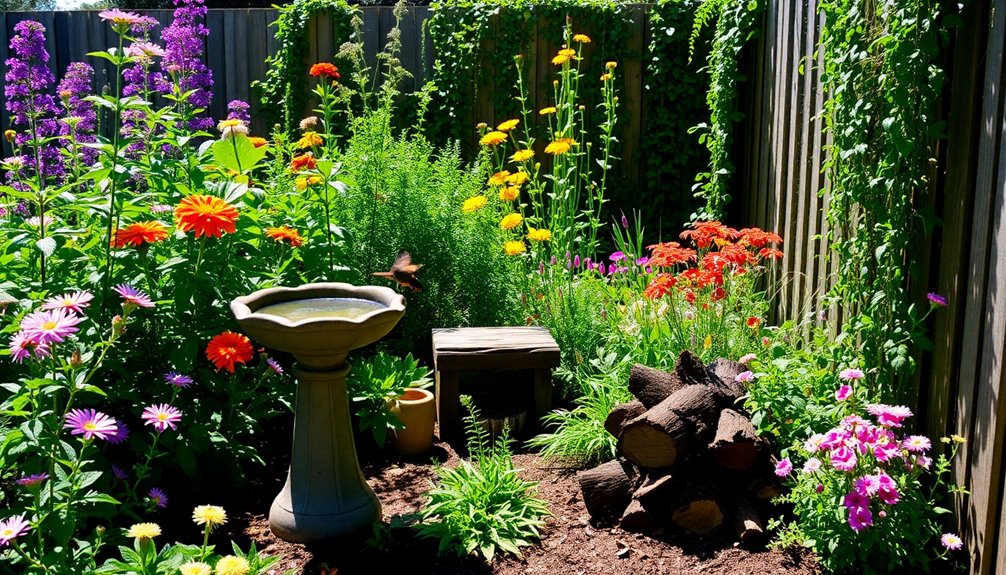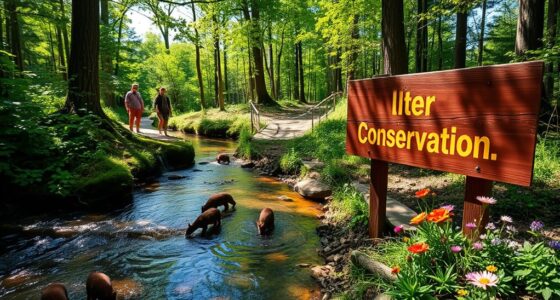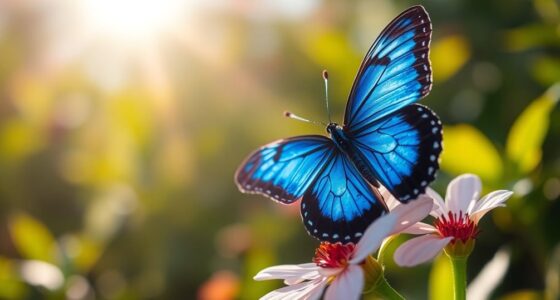To create a wildlife-friendly garden, start by choosing native plants that attract local pollinators and require less maintenance. Provide food sources like berry-producing shrubs and flowering plants for bees and birds. Create shelter with native trees and brush piles for hiding spaces. Incorporate water features such as birdbaths or ponds to offer hydration. Avoid pesticides and chemicals to protect wildlife. Consider adding wildlife corridors for safe movement. You'll discover even more ways to enhance your garden's appeal!
Key Takeaways
- Plant native flowering plants and berry-producing shrubs to provide food sources for local pollinators and birds.
- Incorporate native trees and shrubs to create natural cover and nesting areas for wildlife.
- Add water features like ponds or birdbaths to attract birds and other animals needing hydration.
- Use organic gardening practices, such as composting and mulching, to support a healthy ecosystem.
- Leave some areas of the garden wild to allow native plants to thrive and provide natural shelter.
Choose Native Plants for Your Garden
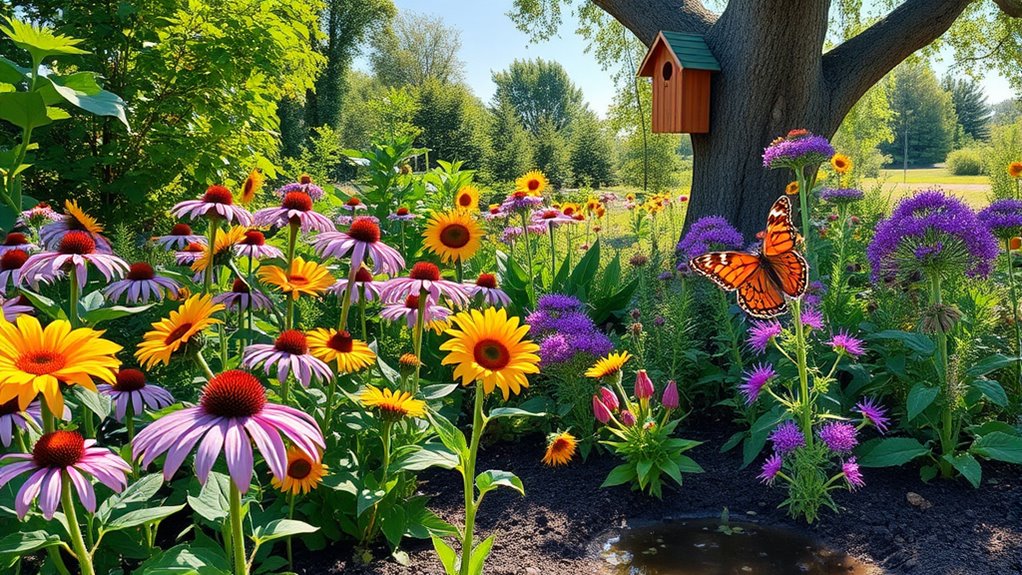
When you choose native plants for your garden, you're not just enhancing its beauty—you're also creating a thriving habitat for local wildlife.
Native plants are adapted to your local climate and soil, making them easier to grow and maintain. They require less water and fewer chemicals, which means you'll spend less time and money on upkeep.
Native plants thrive in your local climate, needing less water and maintenance, saving you time and money.
By planting species that are native to your area, you encourage local pollinators like bees and butterflies, as these plants provide the right environment for them to thrive.
Additionally, native plants often resist pests better than non-natives, reducing your need for pesticides.
Provide Food Sources for Wildlife
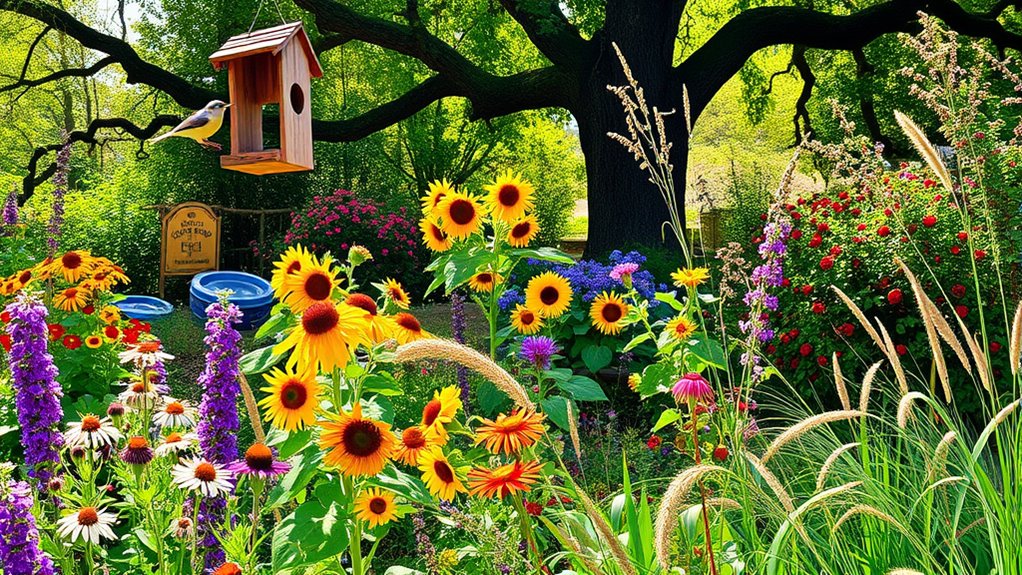
To create a truly wildlife-friendly garden, you should provide a variety of food sources that cater to different species.
Start by planting native flowering plants that produce nectar for bees, butterflies, and hummingbirds. Incorporate berry-producing shrubs like elderberry and serviceberry to attract birds and other wildlife.
Don't forget about trees; oaks and maples provide acorns and sap, drawing in squirrels and various birds. You can also add a small vegetable patch or herbs, which can offer food for both pollinators and local critters.
If you're feeling crafty, consider setting up bird feeders filled with seeds or suet to nourish your feathered friends.
Create Shelter and Nesting Areas

Creating shelter and nesting areas is essential for attracting and supporting wildlife in your garden. Start by adding native shrubs and trees, which provide natural cover and nesting spots for birds and small mammals.
You can also create brush piles using fallen branches and leaves, offering safe hiding places for various critters. For birds, consider installing birdhouses at varying heights to cater to different species. Use materials like untreated wood or natural fibers to build or buy these houses.
Don't forget to leave some areas of your garden wild, allowing native plants to thrive, which can serve as natural shelters.
Incorporate Water Features

Incorporating water features into your garden not only enhances its beauty but also attracts a variety of wildlife.
Whether it's a small pond, a birdbath, or a fountain, these elements provide essential hydration and habitats for birds, butterflies, and frogs. You can create a simple pond by digging a shallow area and lining it with a pond liner.
Add native plants around the edges to offer shade and shelter. If space is limited, a birdbath filled with fresh water will suffice. Ensure the water is clean and changed regularly to keep wildlife healthy.
Avoid Pesticides and Chemicals
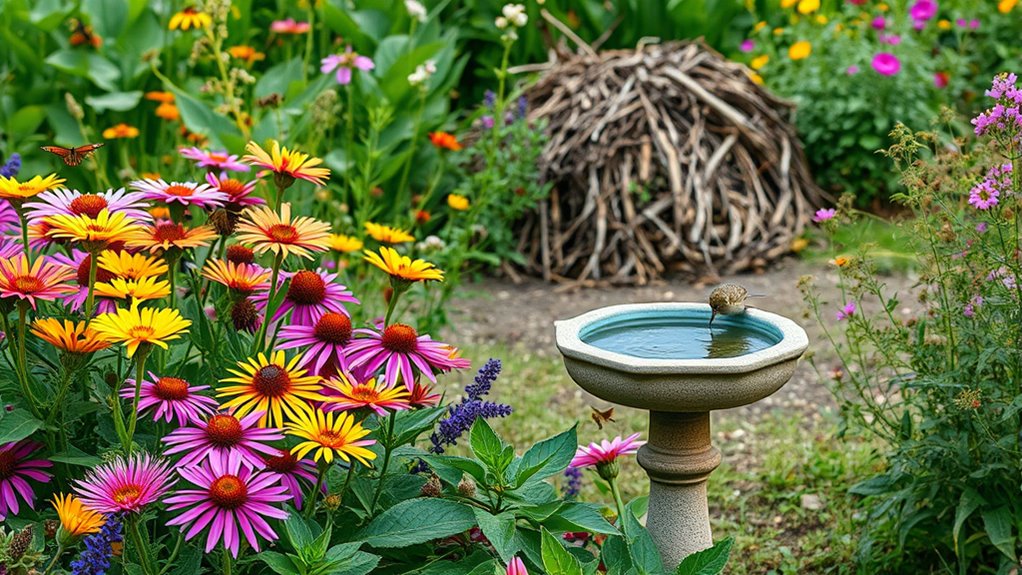
While it might be tempting to use pesticides and chemicals to keep your garden looking pristine, doing so can harm the very wildlife you aim to attract. These substances can poison beneficial insects, birds, and other creatures that contribute to a healthy ecosystem.
Instead, consider natural alternatives like neem oil, insecticidal soap, or introducing beneficial insects like ladybugs and lacewings. You can also encourage birds, which eat pests, by providing suitable nesting sites and feeders.
Explore natural pest control methods like neem oil and beneficial insects to foster a vibrant, eco-friendly garden.
Focus on cultivating healthy soil and diverse plant life to create a balanced environment that naturally deters pests. By avoiding harmful chemicals, you'll not only protect wildlife but also promote a thriving garden that's beautiful and sustainable.
Your garden can flourish without compromising the ecosystem.
Design With Wildlife Corridors in Mind

To ensure your garden supports local wildlife, think about how to create pathways that allow animals to move freely between habitats.
Design your layout with narrow corridors that connect different areas, such as flower beds, shrubs, and trees. Native plants can create natural tunnels, providing both shelter and food for various species.
Avoid fencing or barriers that block movement; instead, use features like logs or rocks to encourage safe passage. Incorporate water sources, like ponds or bird baths, to attract animals and enhance connectivity.
Implement Sustainable Gardening Practices
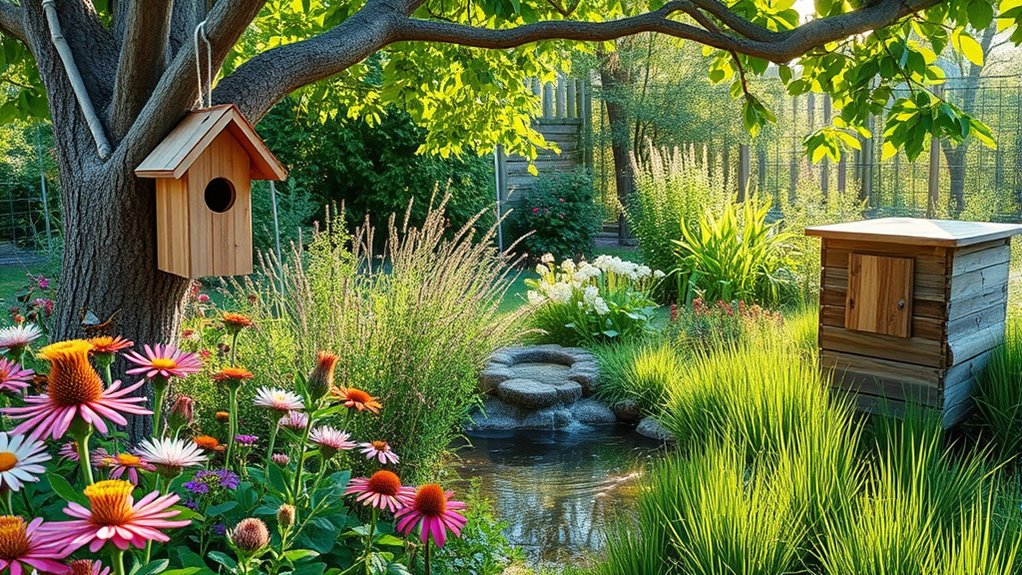
Sustainable gardening practices not only benefit the environment but also enhance the health of your garden.
Start by using organic fertilizers and compost to enrich your soil naturally. This reduces chemical runoff and promotes healthy plant growth.
Choose native plants that are well-adapted to your area; they require less water and maintenance.
Implement crop rotation and companion planting to improve soil nutrients and deter pests without harmful pesticides.
Mulching helps retain moisture and suppress weeds, making your garden easier to manage.
Collect rainwater for irrigation to conserve resources and reduce your water bill.
Lastly, minimize lawn areas; they require excessive water and chemicals.
These practices create a thriving ecosystem, supporting both wildlife and your garden's sustainability.
Include Pollinator-Friendly Flowers

Including pollinator-friendly flowers in your garden not only attracts bees, butterflies, and other beneficial insects but also enhances the overall biodiversity of your outdoor space.
Choose a variety of native plants, as they're better suited to your local pollinators. Consider planting species like coneflowers, bee balm, and sunflowers, which provide nectar and pollen.
Select diverse native plants, such as coneflowers, bee balm, and sunflowers, to support local pollinators with essential nectar and pollen.
Grouping flowers in clusters makes it easier for pollinators to find them, so don't hesitate to plant in patches. Opt for blooms of different shapes and colors to appeal to a wider range of species.
Be mindful of blooming times, ensuring you have flowers available throughout the growing season.
Educate Others About Wildlife Conservation
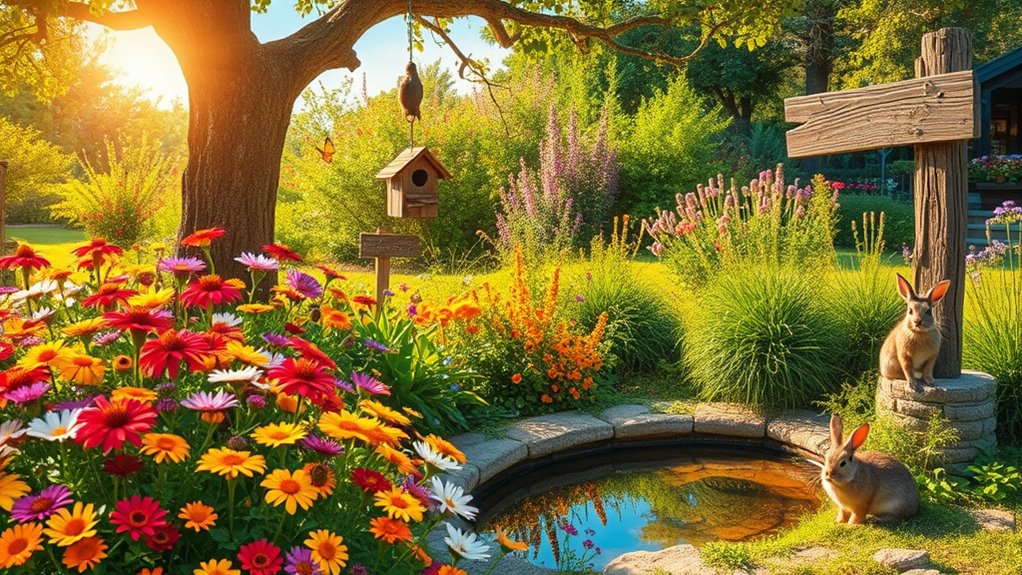
Creating a pollinator-friendly garden is just one step in fostering a healthy ecosystem.
To make a real impact, you should share your knowledge about wildlife conservation with friends, family, and your community. Start conversations about the importance of native plants, sustainable gardening practices, and the role of wildlife in our environment.
Host workshops or join community events to spread the word. Use social media to share your garden's progress and tips for creating wildlife-friendly spaces.
By educating others, you not only inspire them but also create a ripple effect that can lead to more gardens benefiting local wildlife.
Frequently Asked Questions
How Do I Attract Specific Types of Wildlife to My Garden?
To attract specific types of wildlife to your garden, you need to understand their needs.
Start by researching the species you want to invite. Provide suitable food sources, like native plants or specific feeders.
Create shelter with shrubs or birdhouses, and ensure a water source is available.
Avoid pesticides, as they can deter wildlife.
Lastly, maintain a diverse habitat to support various animals, increasing your chances of attracting the wildlife you desire.
What Should I Do if Wildlife Damages My Plants?
If wildlife damages your plants, assess the extent of the damage first.
You can try using natural deterrents like garlic or cayenne pepper sprays to keep them away.
Consider protective barriers, such as fences or netting, to shield vulnerable areas.
Planting native species that wildlife prefers can also help redirect their focus.
Can I Have a Wildlife-Friendly Garden in an Urban Setting?
Absolutely, you can create a wildlife-friendly garden in an urban setting!
Start by incorporating native plants that attract local pollinators. Add elements like bird feeders, water sources, and shelter, such as birdhouses or native shrubs.
Even small spaces like balconies or community gardens can support wildlife.
Just remember to use organic gardening practices to keep the environment safe.
With a little creativity, your urban garden can thrive and support local wildlife!
How Often Should I Maintain My Wildlife-Friendly Garden?
You should maintain your wildlife-friendly garden regularly, ideally every couple of weeks during the growing season. This keeps plants healthy and provides shelter for critters.
Check for weeds, dead plants, or pests, and prune when necessary. Don't forget to replenish mulch or compost to enrich the soil.
Also, observe the wildlife visitors; their presence can guide you in adjusting your maintenance routine for a thriving, inviting space.
What Are the Best Times of Year to Plant for Wildlife?
Imagine a vibrant tapestry of flowers blooming in your garden, inviting bees and butterflies to dance among the petals.
The best times for you to plant for wildlife are spring and fall. In spring, the soil warms up, encouraging new growth, while fall offers a chance to establish roots before winter.
Conclusion
By creating a wildlife-friendly garden, you're not just enhancing your outdoor space—you're also supporting local ecosystems. Imagine stepping outside to see butterflies flitting among native flowers or birds nesting safely in your carefully crafted shelters. It's a beautiful way to connect with nature while helping it thrive. So, why not transform your garden into a vibrant haven for wildlife? Every small effort counts, and your garden can become a vital part of the solution.
